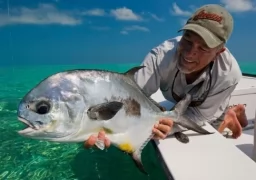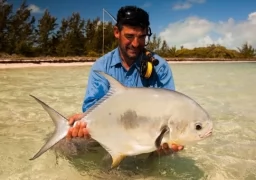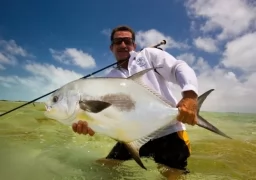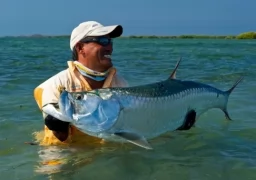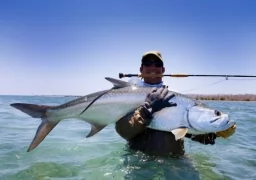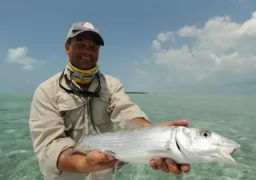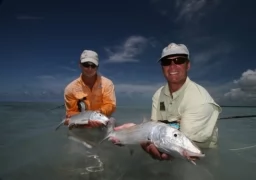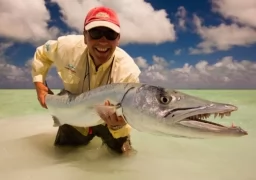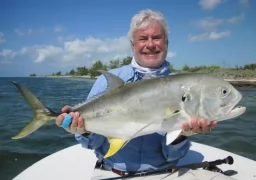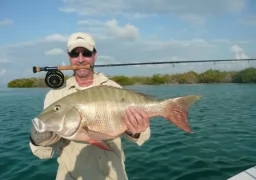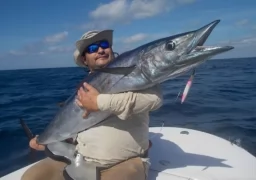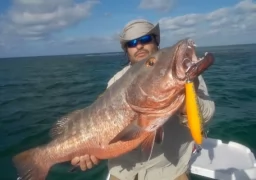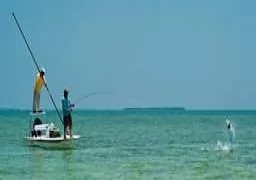INTRODUCTION
Introduction - The Best Grand Slam
Bonefish: This fish is quick and it moves in the white sand areas. In Southern Cuba, the bonefish is abundant and it is not unusual to see them moving in schools of 5 to 60 or more fish. They weigh from 2-14 pounds, and the size and quantity of the species has increases considerably each season since the conservation laws went into effect. Bonefish are sight fished to, by casting between 1 and 4 meters ahead of the (cardumen), considering the direction they are headed. Once they take your fly, they are extremely combative; shooting extensive runs that often leave our backing exposed and put our ability to the test, in a mixture of adrenaline and power.
Tarpon: The giant of the inshore fish is found 90% of the time by sight fishing. Tarpon move in (cardumenes) of 2-40 fish, in search of its favorite food, sardines. The larger tarpon will often move around and feed in a solitary fashion. They range in size from 20-150 pounds and as they are migratory, they are found along the southern coast of Cuba between the months of February and the end of July. They move along the reef line and on some occasions, especially on cloudy days with poor visibility, you can often find them in the channels, or in the mangroves. Fishing this species requires great ability from the guides, who need to use the push pole to move the skiff along the coral line. The fishing technique, as mentioned, is by sight and the line is cast some 5 meters ahead of their mouths, trying to create the natural movement of the fly. The retrieve should look natural, by pulling the line in long and slow jolts, speeding up the fly when the Tarpon approaches. Once they are fooled by your imitation fly and take it in, the fight begins with a mix of jumps, acrobatics, and brute strength. The aggressively long runs, which occasionally go over 150 meters, are a testament to the power and strength of this wonderful fish. What increases the level of satisfaction of landing one of these beautiful monsters is the anxiously awaited photograph we take on landing the fish that will fill a very special spot in our collection.
Permit: Already mentioned, this fantastic fish can leave an angler sleepless and in search of a prized grand slam. The difficulty of fishing it lies in its enormous quality and development of its senses. It has excellent sight and is very sensitive to all environmental changes around it, which is why a badly presented fly, or one that does not move naturally, are very unlikely to fool them. In Cayo Largo one fishes for permit, generally, when they ride the stingrays, while they take advantage of the rays moving the sandy bottoms in search of food (crabs and shrimp). Sometimes they ride for a while over just one ray, while other times permit will move from one ray to the next. While Permit hover near the backs of the rays, their vision is less acute due to the cloudy water and their preoccupation with feeding. They are often more willing to take a fly in this situation than in just about all other scenarios where permit are encountered by anglers. In all cases, the angler should cast flawlessly at least 20 meters to have a chance at this species, which is why we recommend casting lessons to those in need, before coming to Cuba. The fight is simply unlike anything else – and not for those of weak heart. Just to have your line being pulled in the opposite direction by a permit and feel it in your hands for a brief moment, just long enough for a photo documenting the occasion, is an unforgettable memory in any angler\'s life.
Snook: This sly fish completes the Grand Slam and Super Grand Slam and has its principal refuge in the mangroves, where it camouflages and feeds on the (forrajera) species which share its habitat. It is found in southern Cuba, principally between February and July, where its weight is generally between 15 and 30 pounds. However, on numerous occasions, one can find specimens that are considerably larger. The technique for fishing snook is either by sight fishing or blind casting and always casting from the skiff (a los palos de la costa). Anglers will need to exercise extreme precaution in order to pull in the first meters of line once the snook has taken the fly, so as to stop the fish from running back into the mangroves and breaking off. The work with the flies must be done in long pulls, similar to the method used for baby tarpon.

